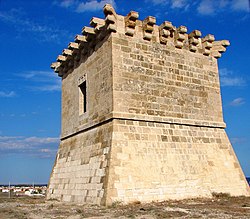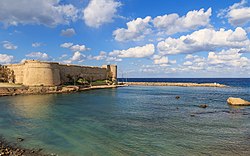Castles/Fortresses
| Name | District | Era | Image | Coordinates |
|---|---|---|---|---|
| Paphos Castle Κάστρο της Πάφου / Baf Kalesi | Paphos | 11th century |  | 34°45′13″N32°24′25″E / 34.75367°N 32.406911°E |
| Saranta Kolones Castle (Forty Columns Castle) Κάστρο Σαράντα Κολώνες / Saranta Kolones Kalesi | Paphos | 13th century |  | 34°45′28″N32°24′35″E / 34.757656°N 32.409644°E |
| Kouklia Tower Πύργος Κουκλιών / Kuklia Kulesi | Kouklia | 12th century |  | 34°42′21″N32°34′23″E / 34.705860°N 32.573100°E |
| Episkopi Castle Κάστρο Επισκοπής / Episkopi Kalesi | Episkopi | 12th century |  | 34°39′51″N32°54′18″E / 34.664204°N 32.905016°E |
| Kolossi Castle Κάστρο του Κολοσσιού | Limassol | 13th century |  | 34°39′55″N32°56′02″E / 34.665273°N 32.933957°E |
| Limassol Castle Κάστρο Λεμεσού / Limasol Kalesi | Limassol | 12th century |  | 34°40′20″N33°02′29″E / 34.6722°N 33.0415°E |
| Choirokoitia Castle Κάστρο Χοιροκητίας / Choirokoitia Kalesi | Choirokoitia | 13th century | ||
| Alaminos Tower Ο Πύργος της Αλαμινού / Aleminyo Gözetleme Kulesi | Larnaca | 14th century | 34°48′24″N33°26′12″E / 34.8067858°N 33.4368011°E | |
| Tower of Regina (Kiti Tower) Ο Πύργος της Ρήγαινας / Bahçeler Kiti Kulesi | Larnaca | 16th century |  | 34°50′10″N33°35′20″E / 34.8360755°N 33.5889224°E |
| Larnaca Castle Κάστρο Λάρνακας / Larnaka Kalesi | Larnaca | 12th century |  | 34°54′37″N33°38′16″E / 34.910271°N 33.637694°E |
| Xylophagou Tower Ο Πύργος της Ξυλοφάγου / Xylofagou Gözetleme Kulesi | Larnaca (Dhekelia) | 16th century | 34°57′01″N33°51′21″E / 34.950326°N 33.855896°E | |
| Pyla Tower Ο Πύργος της Πύλας / Pile Kulesi | Larnaca | 16th century |  | 35°00′32″N33°41′24″E / 35.009°N 33.69°E |
| Othello Castle Κάστρο της Oθέλλου / Othello Kulesi Famagusta Castle Κάστρο της Αμμόχωστου | Famagusta (Gazimağusa) | 14th century |  | 35°07′40″N33°56′36″E / 35.127688°N 33.943239°E |
| Siguri Castle Κάστρο Σιγούρης/ Sigouri Kalesi | Kouklia | 12th century | ||
| Potamias tower Πύργος Ποταμιάς / Potamia Kalesi | Potamia | 14th century | ||
| La Cava Castle Κάστρο Λα Κάβα / La Cava Kalesi | Nicosia | 12th century |  | 35°08′07″N33°24′37″E / 35.135186°N 33.410197°E |
| Gastria Castle Κάστρο Γαστριών / Gastria Kalesi | Famagusta | 12th century |  | 35°19′27″N33°58′46″E / 35.324033°N 33.979498°E |
| Kantara Castle Κάστρο της Καντάρας / Kantara Kalesi | Famagusta (İskele) | 10th century |  | 35°24′23″N33°55′24″E / 35.4064°N 33.9233°E |
| Buffavento Castle Kάστρο Βουφαβέντο / Buffavento Kalesi | Kyrenia (Girne) | 11th century |  | 35°17′15″N33°24′37″E / 35.287456°N 33.410185°E |
| Kyrenia Castle Κάστρο της Κερύνειας / Girne Kalesi | Kyrenia (Girne) | 7th century |  | 35°20′29″N33°19′20″E / 35.341389°N 33.322222°E |
| Saint Hilarion Castle Κάστρο του Αγίου Ιλαρίωνα / Saint Hilarion Kalesi | Kyrenia (Girne) | 10th century |  | 35°18′44″N33°16′51″E / 35.3123°N 33.2808°E |
| Profitis Elias Castle Κάστρο Προφήτη Ηλία / Profitis Elias Kalesi | Kyrenia | 12th century |  | 35°18′44″N33°16′51″E / 35.3123°N 33.2808°E |
| Akaki Castle Κάστρο του Ακακίου / Akaki Kalesi Tower of the Franks Πύρ]γος των Φράγκων | Nicosia | 14th century | 35°18′20″N33°13′44″E / 35.305536°N 33.228778°E | |
| Pyrgos Tiliria Tower | Nicosia | 13th century | ||
| Muti tis Rigena Tower | Akamas | 13th century | ||




